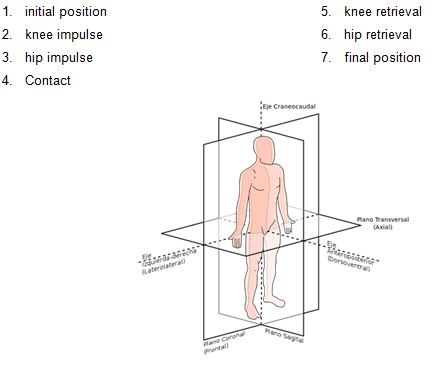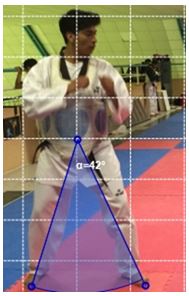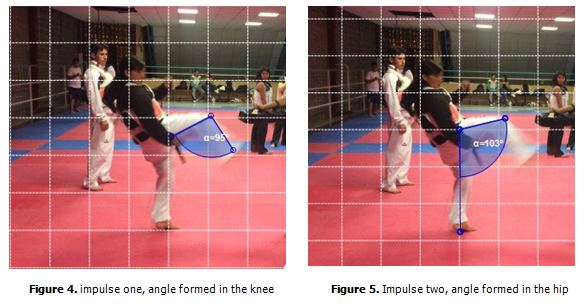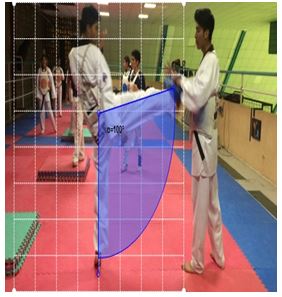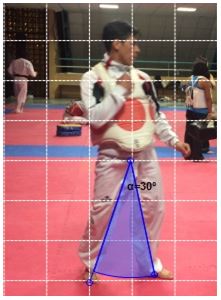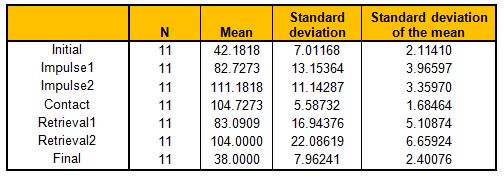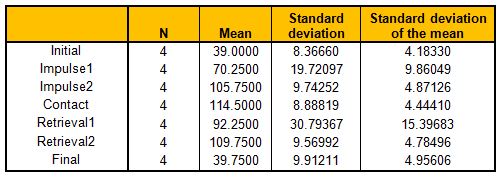
|
|||
|---|---|---|---|
|
|
Biomechanical analysis of the Taekwondo Ap-Chagui kick Análisis biomecánico de la patada Ap-Chagui en Taekwondo |
|
|
|
*Departamento de Ciencias Humanas y Sociales Universidad de las Fuerzas Armadas ESPE **Departamento de Ciencias de la Energía y Mecánica Universidad de las Fuerzas Armadas ESPE (Ecuador) |
Carolina Alejandra Granda Balarezo* MSc. Eduardo Marcelo Loachamin Aldaz* MSc. Sandra Magdalena Arla Odio** |
|
|
|
Abstract The present paper is aimed at the study and biomechanical analysis of the ap-chagui pick with taekwondo athletes of the Universidad de las Fuerzas Armadas ESPE, Sangolqui, Ecuador. Biomechanics is considered the science that studies the internal and external forces that act on the human body, as well as the effects produced by those forces. As a science biomechanics allows more effectiveness and efficiency in any academic, sport and social activity. It will be made a biomechanical analysis to a technique of the Ap-Chagui kick of taekwondo, applying a mathematic model and the Kinovea program, which allows determining factors such as: speed, acceleration, articulatory angle, strength, power, kinetic energy, among others. The scientific knowledge is vital for students, practitioners, teachers and coaches, since the biomechanical models will help us considerably in the improvement of the move due to non-perceptible factors in the execution of the technique. Keywords: Biomechanics. Taekwondo. Ap-chagui kick. Ecuador.
Resumen La presente investigación esta direccionada al estudio y análisis biomecánico de la patada ap-chagui con los deportistas de Taekwondo de la Universidad de las Fuerzas Armadas ESPE, Sangolqui, Ecuador. La biomecánica es considerada la ciencia que examina fuerzas internas y externas que actúan sobre el cuerpo humano, así como también, los efectos producidos por dichas fuerzas. Como ciencia la biomecánica permite ser más efectivos y eficaces al realizar cualquier actividad académica, deportiva o social. Se realizara un análisis biomecánico a una técnica de la patada Ap-Chagui de taekwondo, aplicando modelo matemático y el programa Kinovea, el cual nos permite determinar factores como: velocidad, aceleración, ángulo articulatorio, fuerza, potencia, energía cinética entre otros. Es de vital importancia para estudiantes, practicantes, profesores y entrenadores el conocimiento científico, ya que los modelos biomecánico nos ayudara considerablemente en la optimización del movimiento debido, a factores no imperceptibles en la realización de dicha técnica. Palabras clave: Biomecánica. Taekwondo. Patada Ap-chagui. Ecuador.
Agradecimientos Al Proyecto “Gestión de competencias para publicaciones científicas en estudiantes de pregrado y postgrado de la Universidad de las Fuerzas Armadas ESPE”.
Reception: 05/19/2016 - Acceptance: 06/30/2016
1st Review: 06/19/2016 - 2nd Review: 06/28/2016
|
|||
|
|
EFDeportes.com, Revista Digital. Buenos Aires - Año 21 - Nº 218 - Julio de 2016. http://www.efdeportes.com/ |
|
|
1 / 1
Introduction
We can state that biomechanics is the movement of living beings, based on the laws of mechanics depending on the field, in this case sports (Rull, 2007; Özkaya, Nordin, Goldsheyder and Leger, 2012; McGinnis, 2013).
In the last few years, the progress of the measurement techniques, the record and processing of data have contributed to a large extent to the analysis of the human motion, as it is defined by Leite (2012) and by Quintero (2007).
The principle of the inertial force states that every body movement with which one intends to reach a high final speed (e.g. Handball throws) must be preceded by an impulse in opposite direction (Monterrosa, Díaz & Jiménez, 2008; Puentes & Calero, 2014; León, Calero & Chávez, 2014).
For that reason, there is the principle of optimal trajectory of acceleration, which states that in every body movement with which one intends to reach a high final speed (e.g. Discus throw in athletics) the optimal length of the acceleration trajectory must be used, and it will depend of the magnitude of the stopping impulse in relation with the acceleration impulse.
On the other hand, the coordination principle of partial impulse states that every body movement with which one intends to reach a high final speed will depend on a series of aspects that favour the extension of the itinerary of acceleration and a higher muscular efficacy (Guillamón, 2014; Freixas, 2014).
In combat and game sports the technique reaches varied and complex levels (Attili, 2013; López, 2014; Snarr, Eckert y Abbott, 2015), having several goals, such as the increase of precision, coordination of the individual techniques, avoiding the defensive anticipation of the rival and the appropriate execution in extreme changing conditions, etc., as it is demonstrated by Terga (2003).
Taekwondo has developed its combat system using the kicking techniques in a bigger proportion than those with hands (Franchini, Tabben & Chaabene, 2014; Haddad, Ouergui, Hammami & Chamari, 2015; Ouergui, Haddad, Hammami & Chamari, 2015) because of that its kicking techniques are the quickest, most advanced, modern, and effective in the martial arts world, hence that kicks are used in 80 percent of the actions, and only 20 percent are executed with fists, as it is affirmed by Jova (2015).
The taekwondo kick is three times stronger than a fist punch (Estevan Torres, 2009; Guerrero Baño, 2012) given by the same person (Pressure in Kgrs/cm²), and even when its precision is questioned, this is due to the lack of certainty in the attack vs. the fist execution and caused by a poor practice of the kicking techniques. An Olympic practitioner can execute 2 000 kicks per day as it is stated by Freixas (2014), which implies that the training prioritizes specialization of the muscles and specific energetic systems to improve the kick move.
This research centers in a biomechanical analysis of the taekwondo ap-chagui kick in high performance athletes of the Universidad de las Fuerzas Armadas ESPE by observing differences in the intensity of the strength, angles and position of the body at the time of its execution, which would lead to a short-term decision making related to the training process of the team taken as sample of the study.
Material and methods
The population and sample of the research is made up by athletes of the taekwondo club of the Universidad de las Fuerzas Armadas ESPE, Sangolqui Ecuador. The athletes analyzed have experience and according to their coach a better technique to do the ap-chagui kicks. With them we will make a comparison between men and women, this biomechanical analysis of the ap-chagui kick is aimed at visualizing and determining the intensity of the kick from the correct angles used by the athlete from an alleged effective technical gesture.
It will be used a camera of 1080 p HD to 30 fps in order to take exact shots of the move and of the angles that take part in the execution of the ap-chagui kick.
The images will be analyzed with the Kinovea program and the results will be determined by the SPSS v20 program (Statistical Product and Service Solutions).
Methodology

Figure 1. Sequence of the ap-chagui kick and measurement of the angles to be studied
We have considered important to take into account seven angles for the execution of the ap-chagui kick, which we enumerate below:
Figure 2. Axes that make up the blueprints of the space. Image taken from Wikipedia. https://es.wikipedia.org/wiki/Plano_anat%C3%B3mico
With the Kinovea program a grid will be put on each image captured that will serve as a guide in order to take more precise angles.
Then a line is drawn with the guide of the grid that will pass through the hip joint, and as base will serve the angle of the supporting leg.
These are the three axes of the space:
The vertical axis goes from the head to the feet: it is a cranio-caudal axis (head-tail)
The horizontal axis goes from side to side: latero-lateral axis.
The anterior-posterior axis goes from the front to the back: ventral-dorsal axis.
In the initial position is taken the point from the hip and is noted the angle formed from the supporting leg to the leg of the kick.
Figure 3. Initial position of the ap-chagui kick
In the impulse position, from which we have taken two important angles, the first is the one formed by bending the knee of the kicking leg, and the second is the angle formed with the supporting leg and the kicking leg.
For the contact position we take the angle formed from the supporting point drawing a straight line from the foot to the hip and from the hip to the kicking foot.
In the retrieval position, the process is the same as in the impulse, both in the angle formed in the knee as in that of the hip.
For the final position we take into account the angle formed in the hip, the supporting leg and the kicking leg.
Figure 6. Angle formed in the hip when executing the kick
Figure 7. Final position with its angle
Results and discussion
In the collection of data and the measurement made by the Kinovea program, the athletes with experience in competitions and training have improved their technique. So the goal was to determine a mean to establish the proper angles and compare the performance of men and women when executing the ap-chagui kick.
We took into account seven important angles when executing the kick, which can be observed in details thanks to the Kinovea program.
Table 1. Results of the angles taken from the Kinovea program
Men
Athlete
Initial
Impulse
Contact
Retrieval
Final
Knee
Hip
Knee
Hip
1
39
92
106
109
76
92
35
2
50
95
102
100
75
99
42
3
42
90
128
102
121
58
53
4
43
94
99
109
81
131
30
5
48
76
124
113
72
131
34
6
33
65
131
111
76
119
38
7
34
74
109
107
71
122
45
8
36
56
110
102
78
88
23
9
43
93
103
102
80
109
43
10
40
85
107
103
112
87
36
11
56
90
104
94
72
108
39
Table 2. Results of the angles taken from the Kinovea program (women)
Women
Athlete
Initial
Impulse
Contact
Retrieval
Final
Knee
Hip
Knee
Hip
1
50
95
103
103
94
102
45
2
32
52
102
112
52
117
43
3
41
77
120
122
96
119
46
4
33
57
98
121
127
101
25
Table 3. Statistical result for a male sample
Table 4. Statistical result for a female sample
In table three and four are processed the data in the SPSS program, helping the analysis by obtaining the mean in each angle taken. So it was made an analysis of the data comparing the mean and taking a T test, which determined several results.
The table itemizes some values: N, which is the number of athletes undergone to the study; the mean of each angle; the standard deviation, that is to say how much it tends to get distant from the concrete values of the mean; and the standard error of the mean.
By having a slight flexion of the trunk in the hip joint at the highest point of the leg and changing to a slight flexion when lowering it down itt has been found that the frontal kicks executed with the trunk slightly extended were quicker than those with the trunk straight or bended (Park, 1989).
By making a comparison between men and women, it is observed that in the initial position men have an angle of 42.1818 and the mean of women is 39.000. In the first impulse (angle formed by the knee of the kicking leg), men have a result of 82.7273 and women of 70.2500. In the second impulse, the angle formed by the hip in the moment right before executing the kick, the mean determined a value of 111.1818 in men and 105.7500 in women. In the first three positions, we can observe that men have more amplitude in their angles than women. Due to the abovementioned, it is deduced that the training of women should be a priority in order to develop more physical flexibility.
At the moment of executing the kick, it is observed that in the position called “contact”, women has more amplitude in a certain angle, since they can achieve a mean 114.5000, while men reach a mean of 104.7273.
In retrieval 1, which is the moment when the leg starts to come down, it is formed the angle of the knee, and it is observed that women reach an angle of 92.2500 and men of 83.0909. In the next position called “retrieval 2”, women reached a mean of 109.7509 and men 104.0000.
The final position of men acquire a mean of 38.0000 and women 39.7500.
Conclusions
We can conclude that in the “initial position” men start with a bigger angle than women, and at the moment of making the first ascending positions with the kicking leg, the angles of men reach higher values than women, but in the descending moment women reach higher values than men. In the end women reach a wider angle in the last position.
It is deduced that given the physiological characteristics between men and women, the angular amplitude differs in each of the positions studied. However, during the teaching of the technique the kick is executed towards a target for which the technical move is stereotyped towards that objective to which during the teaching-learning process the athletes studied have been undergone.
Bibliography
Attili, D. G. (2013). Planificación del entrenamiento en el Taekwondo Olímpico (WTF). In 10º Congreso Argentino de Educación Física y Ciencias 9 al 13 de septiembre de 2013 La Plata. Universidad Nacional de La Plata. Facultad de Humanidades y Ciencias de la Educación. Departamento de Educación Física.
Castañeda, P. G., Ruiz, D. y Gómez, J.A. (2011). El secreto del éxito en el taekwondo: preparación física y mental para máximos resultados deportivos. Lecturas: Educación Física y Deportes, EFDeportes.com, Revista Digital. Buenos Aires, Año 16, Nº 162, Noviembre. Consultado el día 17 de enero del 2016 de la Web: http://www.efdeportes.com/efd162/el-secreto-del-exito-en-el-taekwondo.htm
Estevan Torres, I. (2009). Estudio sobre parámetros mecánicos y autoeficacia física percibida en la patada" Dolio Chagui" de Taekwondo.
Franchini, E., Tabben, M., & Chaabene, H. (2014). Physiological responses during taekwondo training and competition: review article. International SportMed Journal, 15(4), 500-515.
Freixas, Y. y Cuní, M. (2014). Análisis biomecánico en la aplicación de ejercicios específicos para mejorar la ejecución de la técnica de pierna dollio chagui en el taekwondo. Lecturas: Educación Física y Deportes, EFDeportes.com, Revista Digital. Buenos Aires - Año 19 - Nº 192 - Mayo. Consultado en día 16 de enero del 2016 de la Web: http://www.efdeportes.com/efd192/mejorar-dollio-chagui-en-el-taekwondo.htm
Guerrero Baño, J. A. (2012). Incidencia de la fuerza máxima en la obtención de la potencia en la patada bandal de taekwondo, en los atletas 14-15 años de la selección de taekwondo del Colegio Pedro Vicente Maldonado de la ciudad de Riobamba, en año 2011-2012.
Guillamón, A. R. (2014). Biomecánica de la actividad física y el deporte: objetivos, principios y aparatos de medición. Lecturas: Educación Física y Deportes, EFDeportes.com, Revista Digital. Buenos Aires, Año 18, Nº 188, Enero. Consultado el día 13 de enero del 2016 de la Web: http://www.efdeportes.com/efd188/biomecanica-de-la-actividad-fisica.htm
Haddad, M., Ouergui, I., Hammami, N., & Chamari, K. (2015). Physical Training in Taekwondo: Generic and Specific Training. Performance Optimization in Taekwondo: From Laboratory to Field, 85.
Jova, Y. (2015). Ejercicios tácticos para perfeccionar la efectividad de las acciones de contraataque en las taekwondistas categoría 13-15 años de la EIDE provincial de Villa Clara. Doctoral dissertation, Universidad de Ciencias de la Cultura Física y el Deporte "Manuel Fajardo".
Leite, W. S. (2012). Biomecánica aplicada al deporte: contribuciones, perspectivas y desafíos. Lecturas: Educación Física y Deportes, EFDeportes.com, Revista Digital. Buenos Aires - Año 17 - Nº 170 - Julio. Consultado en día 17 de enero del 2016 de la web: http://www.efdeportes.com/efd170/biomecanica-aplicada-al-deporte.htm
León, S., Calero, S. y Chávez, E. (2014). Morfología funcional y biomecánica deportiva. Quito, Ecuador: Editorial de la Universidad de las Fuerzas Armadas ESPE. http://repositorio.espe.edu.ec/bitstream/21000/9219/3/morfologia%20funcional%20y%20biomecanica%20deportiva.pdf
López, P. A. (2014). Los deportes de combate: un reto en la formación del profesional de Cultura Física. Cultura Física y Deportes de Guantánamo, 4(8), 69-79.
McGinnis, P. M. (2013). Biomechanics of sport and exercise. Champaign, Il: Human Kinetics.
Monterrosa, A., Díaz, A. y Jimenez, C.D. (2008). Análisis biomecánico de la patada bandal chagui del arte marcial taekwondo. Lecturas Educación Física y Deportes, Revista Digital - Buenos Aires - Año 13 - N° 121 - Junio. Consultado el día 16 de enero del 2016 de la Web: http://www.efdeportes.com/efd121/analisis-biomecanico-de-la-patada-bandal-chagui-taekwondo.htm
Ouergui, I., Haddad, M., Hammami, N., & Chamari, K. (2015). Time Motion and Technical and Tactical Analysis of Taekwondo Competition. Performance Optimization in Taekwondo: From Laboratory to Field, 38.
Özkaya, N., Nordin, M., Goldsheyder, D., & Leger, D. (2012). Fundamentals of biomechanics: equilibrium, motion, and deformation. Springer Science & Business Media.
Puentes, E. y Calero, S. (2014). Fundamentals for a biomechanical analysis of Aikido. Lecturas: Educación Física y Deportes, Buenos Aires, Año 19, Nº 190, marzo. Recuperado el 19 de enero de 2016 de la Web: http://www.efdeportes.com/efd190/biomechanical-analysis-of-aikido.htm
Quintero, A. M. (2007). Análisis biomecánico de la técnica shonal chigüí en cinturones negros del arte marcial Taekwondo. Lecturas: Educación Física y Deportes, Revista Digital - Buenos Aires - Año 12 - N° 108 - Mayo. Consultado el día 18 de enero del 2016 de la Web: http://www.efdeportes.com/efd108/analisis-biomecanico-de-la-tecnica-shonal-chigui-taekwondo.htm
Rull, I. M. (2007). Biomecánica clínica de las patologías del aparato locomotor. España: Elsevier.
Snarr, R., Eckert, R. M., & Abbott, P. (2015). A Comparative Analysis and Technique of the Lat Pull-down. Strength & Conditioning Journal, 37(5), 21-25.
Terga, E. V. (2003). El empleo del análisis biomecánico en la práctica deportiva; su estrecha y lógica relación con la técnica deportiva. Primera parte. Lecturas: Educación Física y Deportes, Revista Digital - Buenos Aires - Año 9 - N° 66 - Noviembre. Consultado el día 16 de enero del 2016 de la Web: http://www.efdeportes.com/efd66/biomec.htm
Another articles in English

|
|
|---|---|
|
EFDeportes.com, Revista Digital · Año 21 · N° 218 | Buenos Aires,
Julio de 2016 |
|
